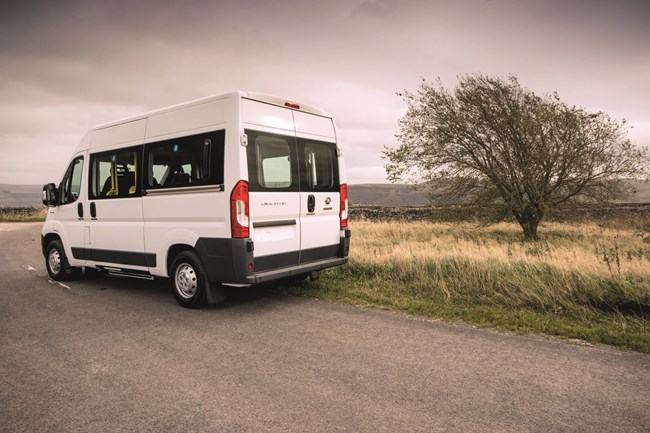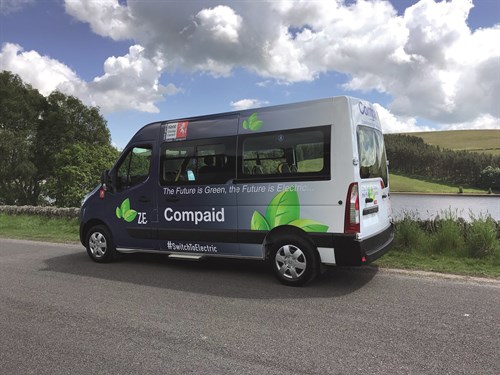- ETRUX launches new Ford E-Transit Trizone
- Renault gives UK debut to Master E-Tech at CV Show
- Isuzu D-Max long-term test – Latest Report
- Isuzu D-Max V-Cross Steel Edition revealed
- IVOTY Report: Stellantis explores the hydrogen proposition
- New Maxus EVs include eDeliver 5 van
- Used LCV values reach six-month high
- ADVERTISEMENT FEATURE: IVECO Daily Mission Awards 2024 Q2 Round-up: Grounds Maintenance & Forestry
- Stellantis Pro One electric vans review
- Mitie adds 5,000th EV to fleet
What Van? Awards 2022: Minibus of the Year – Fiat Professional E-Ducato
Date: Friday, December 17, 2021

With rising concerns over the impact poor air quality is having on children’s health, it makes sense for schools with a diesel minibus to consider switching to a zero-emission battery-electric model. At the other end of the age spectrum, charities that provide services for senior citizens and run a minibus may be thinking along the same lines; and for much the same reason.
That is why the wheelchair-accessible minibus conversion based on Fiat Professional’s electric E-Ducato carried out by Minibus Options is likely to grow in popularity. It’s What Van?’s Minibus of the Year – and it is not hard to see why.
While E-Ducato is available with a five-module 79kWh battery, the Minibus Options conversion is based on the three-module 47kWh variant which feeds a 90kW (122hp) motor. It is available with either an AC or a DC charging capability.
Range is always dependent on the time of year and the prevailing weather conditions, but the 47kWh model should be good for in excess of 100 miles between recharges. That ought to give it more than enough margin to be able to ferry the school chess team from one end of town to the other; and a regenerative braking system will help replenish the battery during the journey.
The Whaley Bridge, High Peak, Derbyshire converter offers two different models; one based on an E-Ducato 3.5-tonner, which can carry eight passengers, and one based on a 4.25-tonner, which can transport 13.
Both vehicles can be configured to carry two passengers in wheelchairs and are equipped with wheelchair restraints and slip-resistant safety flooring. Secured to tracking with anti-rattle locking devices, five of the 3.5-tonner’s and as many as eight of the 4.25-tonner’s seats can be removed to create wheelchair space
The 3.5-tonner comes with a 900mm-wide wheelchair ramp while its heavier stablemate is equipped with an electro-hydraulic wheelchair lift; internally-mounted in both cases. The ramp is complemented by a battery-powered winch, which can be used to tow wheelchairs aboard effortlessly and safely every time.
Each of the E-Ducatos boasts a coach-style three-way adjustable glass roof vent and plenty of handrails and handles to assist with both boarding and alighting.
The lighter of the pair boasts an electrically-operated nearside step, which aids access to the passenger saloon. The 4.25-tonner comes with a nearside step-well formed and fitted with an integral folding step, which lies flush with the saloon floor when not in use.
On both vehicles the step edges are highlighted to aid the partially-sighted.
It typically takes just shy of five hours to recharge the 47kWh battery from zero to 100%. With a 50kW DC charger, however, it can be charged to 100% of its capacity in just 50 minutes; which means it can be replenished during the driver’s lunch hour.
An absence of exhaust emissions is not the only environmental advantage these vehicles enjoy. Both external and internal noise levels are low too, making journeys all the more pleasant for the driver and passengers.
Highly Commended: Renault Trucks Master Z.E

Once again the electric wheelchair-accessible passenger-carrying Master Z.E, developed by Renault Trucks in conjunction with Minibus Options, receives our Highly Commended accolade.
Power is delivered by a 33kWh lithium-ion battery married to a 57kW electric motor. The range between recharges is around 100 miles, with a recharge time of approximately six hours.
An eight-passenger model is on offer with removable seats which permit the passenger saloon to be set out in various different ways. It can play host to two wheelchair users plus three seated passengers, for example; and the wheelchairs and their occupants can be properly and safely secured.
In a praiseworthy initiative, Renault Trucks has recently announced a battery storage capacity increase to 52kWh. That potentially gives the minibus an urban range of over 150 miles according to WLTP (Worldwide Harmonised Light Vehicle Test Procedure) figures, and what the manufacturer describes as a real-world range of nearly 120 miles. If you use a fast-charger, the battery can reach 80% of its maximum charge in two hours, and 100% in three hours.
View The WhatVan Digital Edition


